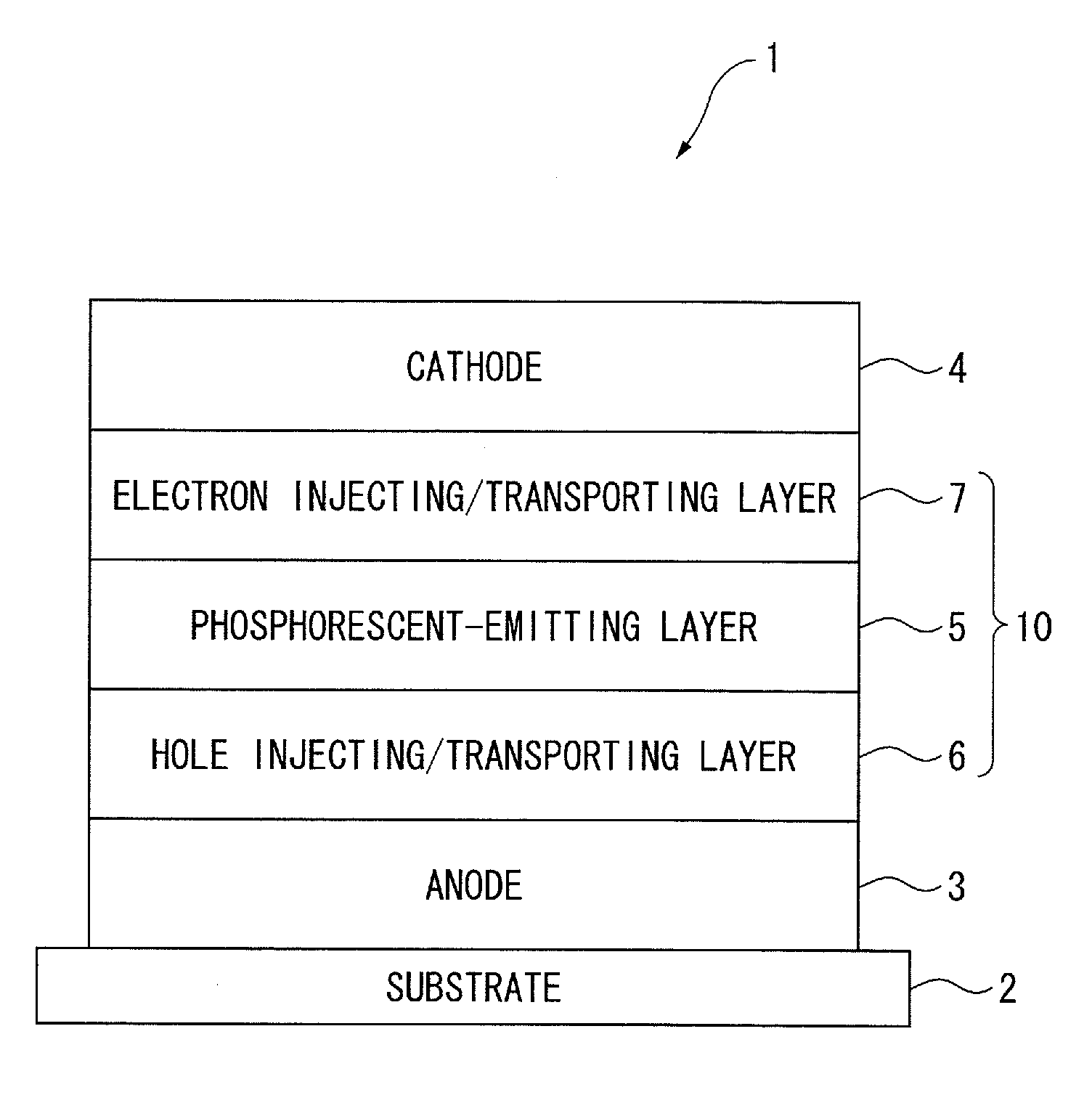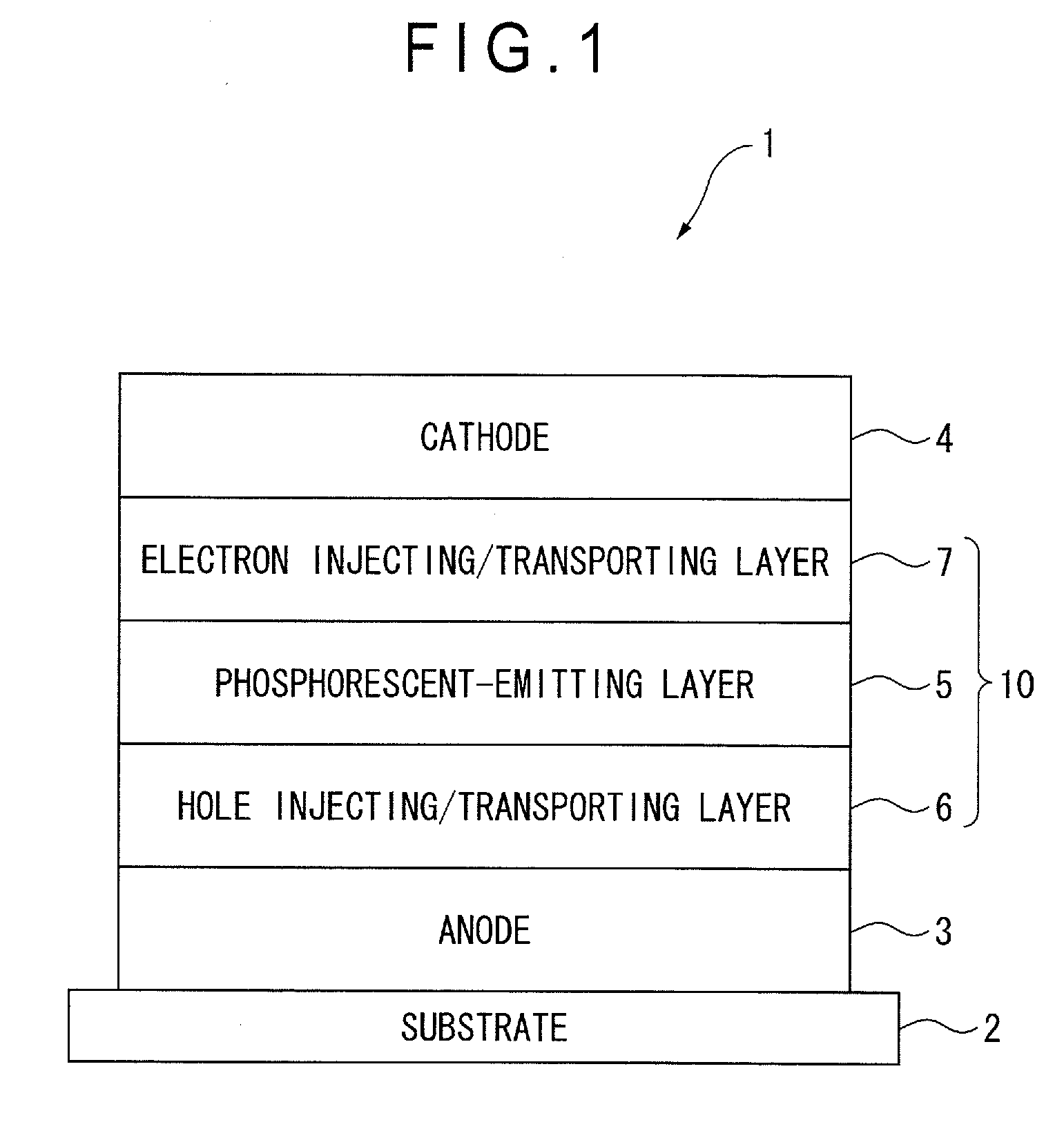Biscarbazole Derivative, Material for Organic Electroluminescence Device and Organic Electroluminescence Device Using The Same
- Summary
- Abstract
- Description
- Claims
- Application Information
AI Technical Summary
Benefits of technology
Problems solved by technology
Method used
Image
Examples
first exemplary embodiment
Arrangement of Organic EL Device
[0093]First of all, arrangement(s) of an organic EL device will be described below.
[0094]The followings are representative arrangement examples of an organic EL device:
(1) anode / emitting layer / cathode;
(2) anode / hole injecting layer / emitting layer / cathode;
(3) anode / emitting layer / electron injecting•transporting layer / cathode;
(4) anode / hole injecting layer / emitting layer / electron injecting•transporting layer / cathode;
(5) anode / organic semiconductor layer / emitting layer / cathode;
(6) anode / organic semiconductor layer / electron blocking layer / emitting layer / cathode;
(7) anode / organic semiconductor layer / emitting layer / adhesion improving layer / cathode;
(8) anode / hole injecting•transporting layer / emitting layer / electron injecting•transporting layer / cathode;
(9) anode / insulating layer / emitting layer / insulating layer / cathode;
(10) anode / inorganic semiconductor layer / insulating layer / emitting layer / insulating layer / cathode;
(11) anode / organic semiconductor layer / insula...
second exemplary embodiment
[0239]Next, an organic EL device according to a second exemplary embodiment will be described below.
[0240]The organic EL device according to the second exemplary embodiment is different in that the emitting layer includes the first host material, the second host material and the phosphorescent material. In this case, the first host material is the biscarbazole derivative according to the exemplary embodiment represented by the formulae (1) to (3).
[0241]The organic-EL-device material represented by the formulae (1) to (3) has a biscarbazole skeleton having an excellent hole transporting capability and a heterocyclic skeleton having an excellent electron transporting capability, which leads to a bi-polar performance sufficient for functioning as a single host. However, a luminous efficiency and a lifetime of the multilayered organic EL device depend on a carrier balance of an entire organic EL device. Main factors for controlling the carrier balance are carrier transporting capability...
third exemplary embodiment
[0285]An organic EL device according to a third exemplary embodiment is different from the organic EL device according to the second exemplary embodiment in that a material having a poor electron capability is used as the second material.
[0286]When a material having an excellent electron injecting capability from the electrode (e.g., LiF) is used as the cathode, a carrier balance in the emitting layer becomes shifted toward the anode. For improving such a disadvantage, it is preferable to select a material having a poor electron injecting capability as the second host material. Specifically, the second host material of this exemplary embodiment is preferably a compound in which A3 is a group represented by the following formula (7B) in the formula (5) or (6).
(M3)c-(L6)d-(M4)e (7B)
[0287]In the formula (7B): M3 and M4 each independently represent a substituted or unsubstituted aromatic hydrocarbon group having 6 to 40 ring carbon atoms; M3 and M4 may be the same or different; L6 repr...
PUM
 Login to View More
Login to View More Abstract
Description
Claims
Application Information
 Login to View More
Login to View More - R&D
- Intellectual Property
- Life Sciences
- Materials
- Tech Scout
- Unparalleled Data Quality
- Higher Quality Content
- 60% Fewer Hallucinations
Browse by: Latest US Patents, China's latest patents, Technical Efficacy Thesaurus, Application Domain, Technology Topic, Popular Technical Reports.
© 2025 PatSnap. All rights reserved.Legal|Privacy policy|Modern Slavery Act Transparency Statement|Sitemap|About US| Contact US: help@patsnap.com



